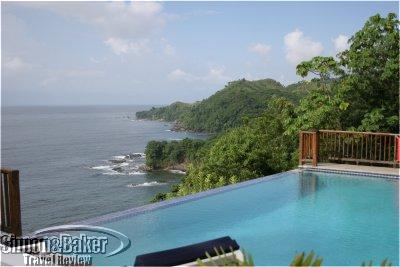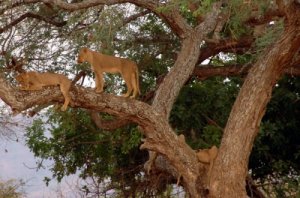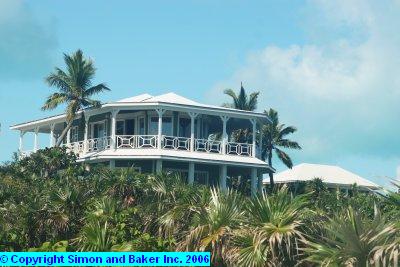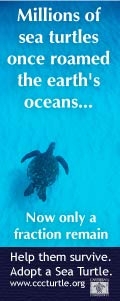by Editor | Dec 4, 2006 | New Articles


Villa de Lena at dusk and ocean view from Being villa
Find out what our travel writers discovered during a recent visit to the island of Tobago, part of Trinidad and Tobago in the Caribbean. To learn about the two luxury villas, attractions and dining out options they liked visit our Tobago pages.
by Editor | Nov 13, 2006 | Accomodations, Ecotourism, Luxury Travel, New Articles

Tree-climbing lions of Chindeni
One of our team members recently returned from the South Luangwa Valley National Park, a ruggedly beautiful 3500-square-mile Eden of savannah and forest wedged in the north-eastern corner of Zambia. The park is recognized by experts as having one of the highest game densities in Africa. According to locals, the now famous Zambian walking safari was pioneered there over half a century ago. The tradition is upheld to this day by a few of the most reputed safari operators in the country. Josette King from the Simon & Baker Travel Review recently visited some of the intimate luxury camps, including Kuyenda, Chimalandu and Chindeni, strategically located along the Luangwa River and its tributaries, and discovered outstanding game viewing.
When she arrived, she settled in her luxury tent raised on a wooden deck overlooking a permanent lagoon at Chindeni, with expectations of abundant wildlife. What she couldn’t have anticipated was a sight so unusual that it startled even James Chabbuka, the group’s seasoned and otherwise unflappable guide. During the group’s first late afternoon excursion near the camp, they came across a pride of lions sprawled high in the branches of a huge winter thorn tree. They were obviously enjoying their nap in the refreshing breeze of the tree tops! Visit these pages and the Simon & Baker Travel Review soon for more about the wonders of South Luangwa Valley walking safaris, including the tree-climbing lions of Chindeni. Click here to read other articles on Zambia.
by Editor | Oct 9, 2006 | Accomodations, Luxury Travel, New Articles

Sugar Beach Villa
We were recently in Exuma, one of the out islands of The Bahamas, for a little rest and relaxation. This sleepy chain of small islands had been mostly undiscovered until a few years ago when luxury tourism in the form of exclusive villa communities and a Four Seasons property with a spa and casino onsite opened shop. Now they’re all the rage. And, with good reason.
The Exuma islands are a stone’s throw from South Florida making them easily accessible. It took us much less time door to door from South Florida to reach our rental villa on Little Exuma, the furthest east of the islands, than it has taken us to reach any island in the Caribbean. For more on the charms of Exuma and a fabulous rental villa go to Exuma and Sugar Beach Villa.
by Editor | Jun 19, 2006 | Ecotourism, New Articles
By Patrick Rose, director, Government Relations, Save the Manatee Club
Patrick Rose, director, Government Relations, Save the manatee Club
Photo: Save the Manatee Club
Despite growing threats to the manatee’s long-term survival and overwhelming public opposition, the Florida Fish and Wildlife Commission (FWC) voted last week to prematurely downlist manatees from Endangered to Threatened. This decision plays right into the hands of those who want to exploit manatee habitat for development and high-speed recreation.
Even though the state found that the manatee population could be reduced by as much as 50 percent in the future and that manatees meet the federal and World Conservation Union’s (IUCN) definition for Endangered, manatees no longer qualify for state Endangered status because the FWC arbitrarily changed its listing/delisting rules by adopting the IUCN criteria for Endangered and then calling it Threatened.
Thirty conservation and animal welfare organizations representing millions of Americans around the nation urged FWC to fix its imperiled species classification system to properly align it with IUCN’s. Thirty-nine manatee and dugong scientists from numerous countries around the world sent a letter in opposition to the manatee’s downlisting. And people from all over the nation called the agency in protest, while hundreds more attended the Commission meeting. Out of scores of speakers at this meeting, only a handful of development, marine industries’ and go-fast boaters’ lobbyists spoke out in favor of downlisting manatees to Threatened!
Further, 17 organizations, filed a legal petition asking the FWC to fix its imperiled species classification system. But, in the end, none of it mattered to the Commissioners.
The FWC insists protections won’t change, but a review of Florida law shows Endangered species are afforded more protection than Threatened species. The Commission claims their Management Plan will protect manatees. However, Florida’s Legislature will be pressured to reduce FWC’s authority and funding to protect manatees. This will undermine the implementation of the Plan, and prevent real recovery.
The FWC and Governor Bush are declaring this a victory for manatees but the facts show otherwise. The agency claims that the manatee population is growing, yet a state report shows that only the 2 smallest subpopulations clearly show growth. Together, these 2 subpopulations only account for 16% of the manatee population. The largest subpopulation on the Atlantic coast shows a probable decline of about 3% per year over the last five years. The Southwest subpopulation is already in decline. Manatees continue to die from boat strikes in near-record numbers and there has been a 17% increase in manatee mortality from boat collisions over the last 5 year period as compared to the previous 5 year period!
Please ask yourself, can all of the organizations representing hundreds of thousands of Florida citizens and millions more people nationwide who have shared their concerns over the new listing process be wrong? I urge the Commission to take a step back from the situation and think about the repercussions to manatees and many other imperiled species if we are right and they are wrong. The consequences will be disastrous. If we are wrong and they are right, then no harm will have been done.
In the meantime manatees’ projected loss of winter habitat could cause catastrophic future losses. This is no time for celebration!
by Editor | Jun 12, 2006 | Accomodations, Luxury Travel, New Articles

Wild dogs at Eagles Crag at the Shamwari Game Reserve, South Africa
San Francisco, California – According to an Opinion Research Corporation national survey sponsored by the Adventure Collection, nearly 10 percent of respondents say they spend $5,000 or more on their adventure travel vacations. In addition, the survey found that 3 percent spent $9,000 or more. Among those with household incomes above $75,000, 17 percent said they spent $5,000 or more on their adventure travel vacations.
While age is not a factor in adventure travel, the Opinion Research survey confirmed that older travelers’ (65+) participation rate is significantly lower (32 percent), but they spend more money on their adventure vacation. And those adventure vacationers over age 35 spend significantly more than those under 35 years of age, although, 18-24 year olds have the highest participation in adventure travel activities at 53 percent.
The survey also found that of the geographic areas evaluated, the West (51 percent) has the highest level of participation in adventure travel followed by the Northeast at 48 percent, the North Central at 45 percent and the South at 41 percent.
“The findings on the adventure traveler were not surprising. It has been our experience, and the survey confirms, the higher one’s income and the more education one has, the more they spend on adventure travel,” said Ben Bressler, president of Adventure Collection member company Natural Habitat Adventures.
Formed in 2000, Adventure Collection comprises 11 independently owned active travel companies that came together through “a shared commitment to operating trips based on quality, experience, environmental responsibility and sustainable tourism.”
To read about ecotourism and adveture articles, visit our Botswana, Peruvian Amazon, http://simonandbaker.com/kruger, Shamwari and Zambia pages.
by Editor | Feb 6, 2006 | New Articles, Restaurants and Food

Raviolis at Le Grand Vefour
Elena, Enrieta and Gary were recently in Paris. If you want the latest skinny of the oh-so-yummy Paris places to eat well (and too much), look for some gourmet restaurant updates soon. They supped at old favorites like Alain Senderens (formerly Lucas Carton), Le Grand Vefour, and Les Crayeres (in Reims, Champagne) and discovered other temples to delicious food like Ledoyen and Helene Darroze. For more information on restaurants we like, visit Simon & Baker Travel Review restaurants.














